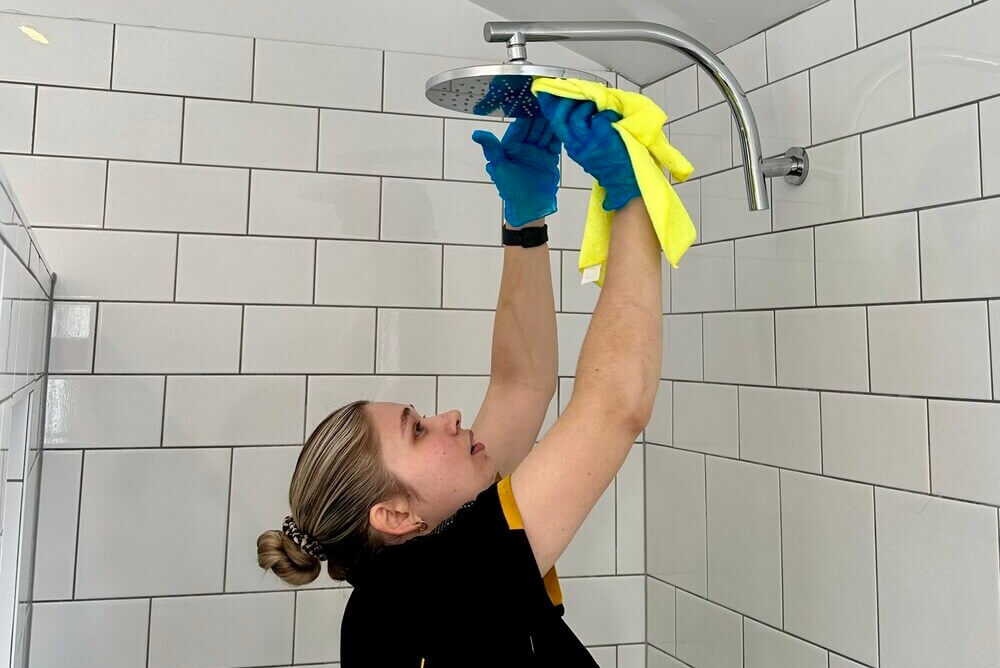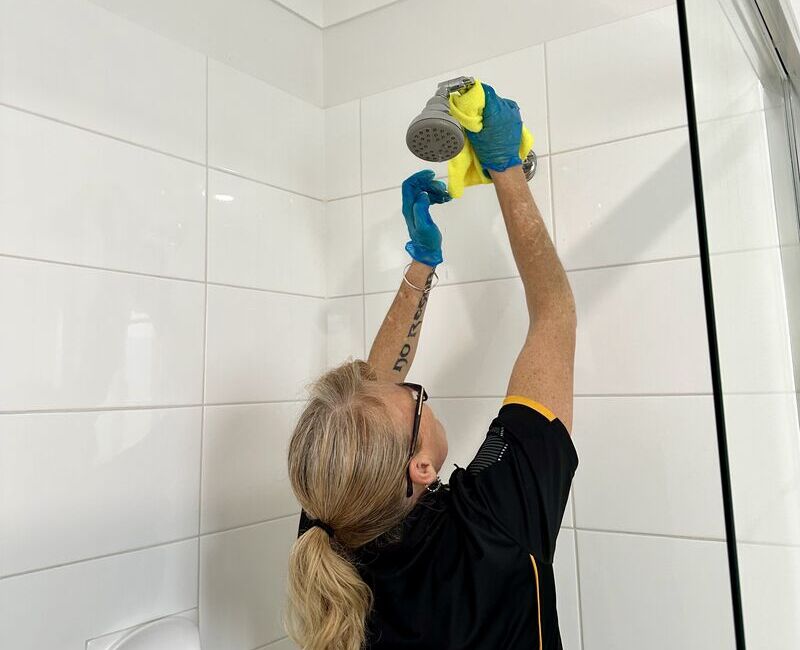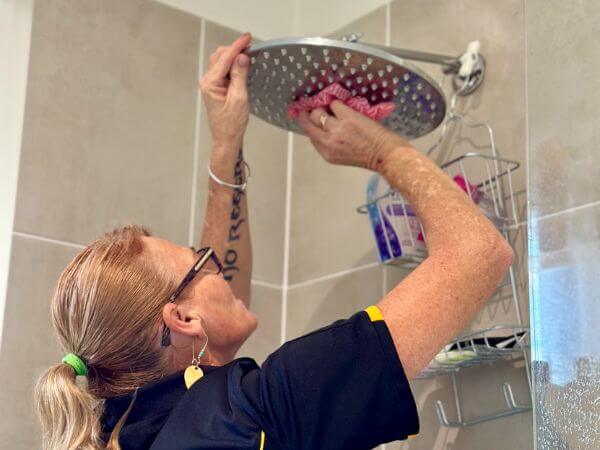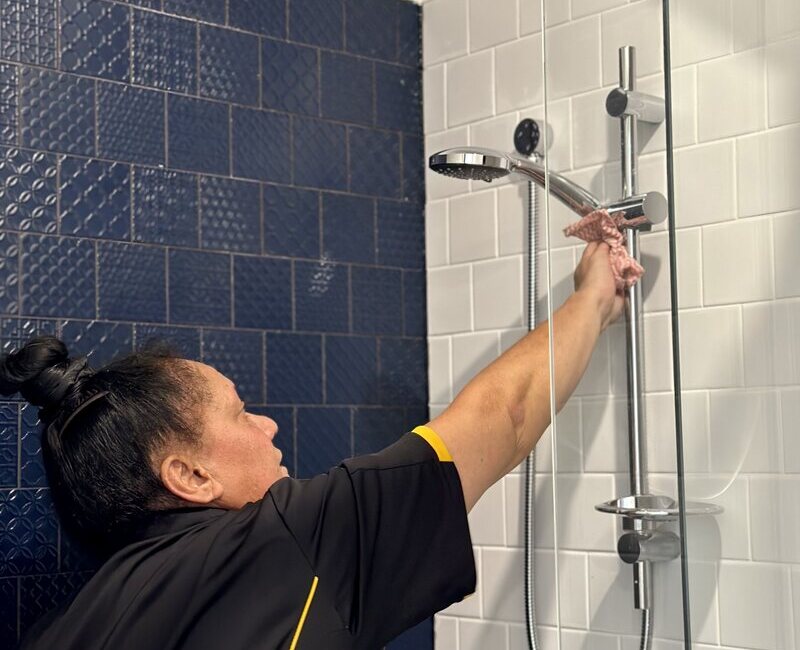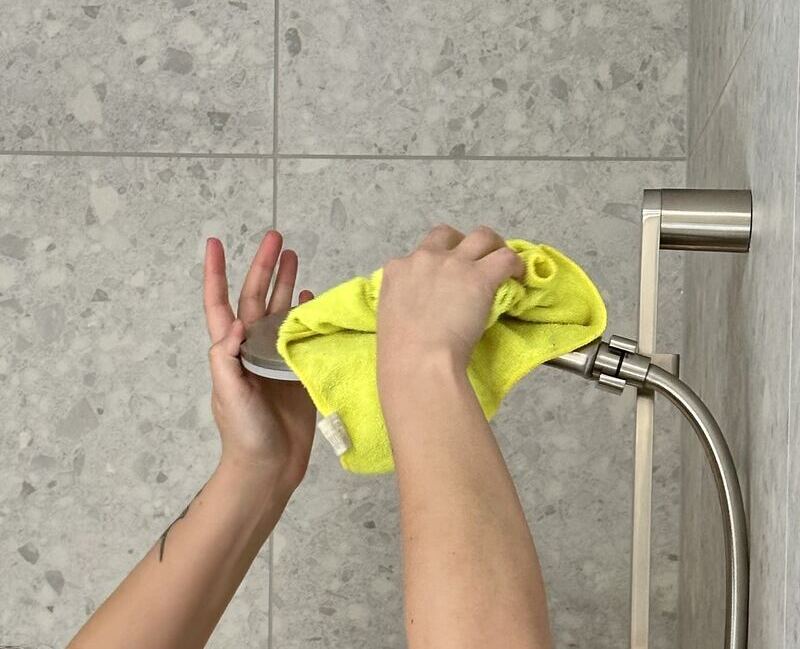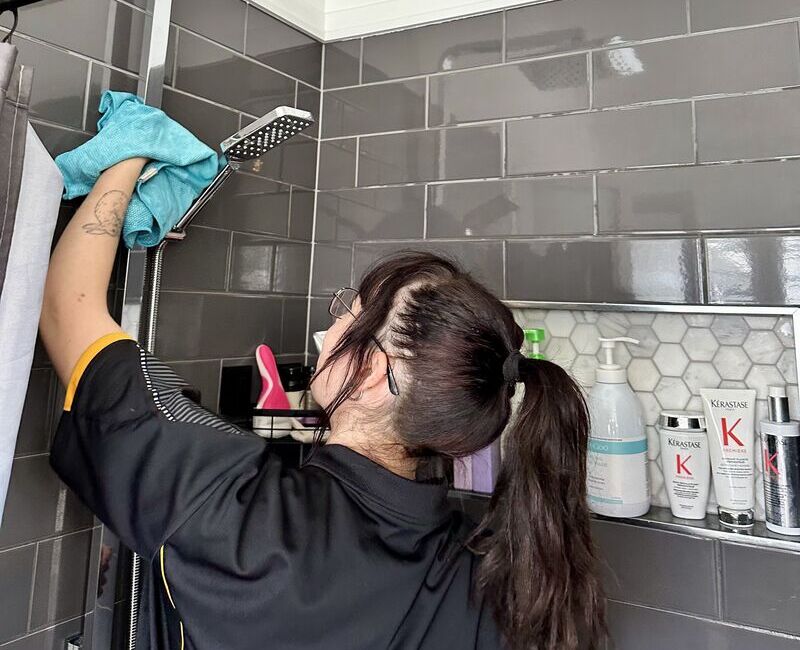Few things can beat the feeling of standing under a hot shower at the end of a long day (or for some of us, first thing in the morning). A good shower always leaves you feeling nice and refreshed.
But while the shower washes you every day, when was the last time you washed the shower head?
It might surprise you to learn how much and how easily grime and mineral deposits build up on the surface and the nozzles (or spray holes). That goes double for people with hard water.
But how to clean a shower head? Some very effective shower head cleaners include white vinegar, citric acid, and CLR.
There’s no fun in singing or acting in the shower if your water is a sad trickle. Time to get scrubbing so you can reenact that dramatic rain scene to full effect.
Cleaning Without Removing the Shower Head | Deep Cleaning | Removing Rust | Cleaning Mould | Maintenance Tips
How Often to Clean Your Shower Head
Lightly clean your shower head about once a week, or as part of your shower cleaning routine.
Deep clean the shower head once a month, including any filters and the hose or pipe.
If you live somewhere with mineral-rich water, you’ll need to clean more often to minimise the buildup of mineral deposits.
Don’t want to stress out over your shower and the rest of your bathroom? Maid2Match’s house cleaners will get the job done for you!
Before Cleaning the Shower Head
Start with a quick inspection of the fixture! Point the shower head away from you (or stay out of the water spray) and turn the shower on high for several seconds.
Normal water flow means the shower head only needs routine cleaning. Reduced water flow indicates a clogged shower head, so you’ll need to be more thorough.
What to use to clean a shower head
It’s important to choose an appropriate cleaning solution based on the material of your shower head! Otherwise, you could end up damaging the finish.
To clean plastic or chrome shower heads, use white vinegar or citric acid.
This solution also works on brass, bronze, copper, and stainless steel shower heads. However, do not leave them to soak for longer than 1–2 hours to prevent etching.
For nickel-coated fixtures, stick to a pH-neutral soap, as acidic cleaners can etch the finish. You can also use a baking soda paste.
Avoid using harsh chemicals like bleach, which can damage the material or leave a residue. Meanwhile, too-abrasive cleaners like steel wool will scuff or scratch the fixture.
Tips for cleaning shower heads
Always work in a well-ventilated bathroom — keep the door and windows open, and switch on the exhaust. Also, protect your skin by wearing rubber gloves.
The most common way to clean a shower head without taking it off is by using a plastic bag to hold your cleaning solution. However, some fixtures (like rain showers) are too big.
In this case, soak a few paper towels in your cleaning solution and wrap them around the shower head. Secure them with some plastic wrap.
For the nozzles, you can use an old toothbrush for scrubbing or a toothpick to remove stubborn deposits.
How to Clean a Shower Head Without Removing It
For regular cleaning, you can leave the shower head attached so it’s easier!
If you can’t reach the shower easily, though, you’ll need a stepstool or stepladder to scrub the fixture clean. Ensure the shower floor is dry so you don’t slip, and get off the stool before you run any water.
Using vinegar
White vinegar is one of the best shower head cleaners! It’s effective at descaling — breaking down limescale or minerals (such as calcium deposits) from hard water.
To clean a shower head with vinegar, pour enough into a plastic bag to cover the fixture. Don’t use too much vinegar, or the bag could overflow.
It’s optional, but you can warm the vinegar in the microwave first. The heat will help loosen the dirt and make it easier to clean calcium buildup.
Place the bag over the shower head, then secure it with some ties or rubber bands. Wait a few moments to see if it slips — you don’t want a vinegar water balloon exploding in your shower!
Let the shower head soak for a few hours (or, for stubborn buildup, overnight). Afterwards, scrub the nozzles and other crevices with an old toothbrush.
Dispose of the vinegar, then run hot water for a minute to flush out any remaining debris. Polish the shower head with a soft cloth when you’re done.
Using pH-neutral soap or baking soda
This method works on all types of shower heads, but it’s best for nickel-coated fixtures.
Mix a little pH-neutral soap (or a similar cleaner) in warm water, then dip in a soft cloth or sponge. Carefully scrub the nickel shower head clean.
For more stubborn dirt, you can make a thin paste out of baking soda, warm water, and a few drops of mild soap. Apply the paste to the shower head with a damp, non-abrasive sponge.
Wait a few minutes, then gently scrub the fixture with the sponge or an old toothbrush. Rinse off any residue, then run hot water afterwards to flush out any remaining debris.
Dry the shower head afterwards before buffing it with a clean microfibre cloth.
Using citric acid
Diluted citric acid is one of the most effective ways to descale a shower head. It reacts with the compounds in limescale, making them easier to remove.
Mix 1 part citric acid powder in 20 parts warm water (about 1 tbsp per 1 cup or a 5% dilution). Soak the shower head in the solution for a few hours, then scrub the fixture with a soft brush or non-abrasive sponge.
For very stubborn limescale, increase the concentration to a 10% dilution — 1 part citric acid to 10 parts water, or 2 tbsp per 1 cup.
Run the hot water for a few minutes afterwards to rinse the shower head. You must rinse off diluted citric acid, or it can leave a sticky residue!
Using CLR
You can use any commercial descaler, but CLR (Calcium, Lime, & Rust Remover) is a great way to tackle limescale.
Follow the instructions on the packaging to make sure you don’t damage the shower head.
Rinse with clean water afterwards, then run the shower for a minute to flush out any residue.
Deep Cleaning a Shower Head
Every month, give your shower head a more thorough cleaning! This lets you tackle deep-seated dirt and check for mould or stubborn grime.
If you need to remove the head from the shower arm or pipe, shut off the water supply first so you don’t accidentally flood the bathroom.
NOTE: If you’ve deep cleaned the shower head and you’re still experiencing low water pressure, there might be an issue with your pipes or water supply. In that case, contact a plumber!
Cleaning the shower head
To start, carefully disconnect the shower head. Unscrew it with a wrench or lockable pliers, or use a cloth when twisting by hand to give yourself good traction.
Place the shower head under strong running water (like a faucet) to flush out debris. You can use hot water to loosen any dirt inside — but wear rubber gloves so you don’t hurt yourself!
Remove the cover and filter screen (if possible), then set the screen aside. Then scrub the shower head with an old toothbrush dipped in white vinegar plus a few drops of dish soap.
Poke out any clogs in the nozzles with a toothpick. For larger debris, use a pair of needle-nose pliers.
Rinse the shower head thoroughly, then let it air dry in a well-ventilated space for an hour or two.
Cleaning the shower filter screen
Leave the shower filter screen to soak in a solution of equal parts white vinegar and warm water while you clean the rest of the shower head!
Afterwards, give it a good scrub with a soft sponge. Be careful not to widen the gaps in the filter or break the mesh.
Rinse the filter screen in fresh water before drying thoroughly. Place it back in the shower head when you’re done cleaning everything.
NOTE: Check how often you’ll need to replace the filter screen — it’s usually around once a year.
Cleaning the shower arm or hose
Give the shower arm or hose a good scrub with a soft sponge dipped in the vinegar and dish soap solution you used for the shower head.
For shower hoses with grooves, opt for a soft brush that can get into the crevices.
If you’ve detached the shower head and can access the inside of the arm, scrub as far inside as you can with an old toothbrush or pipe cleaner.
Don’t worry — when you reattach the shower head and run some hot water, that’ll rinse out the inside of the pipe!
How to Remove Rust From a Shower Head
Metal shower heads typically have a coating to prevent rust, but prolonged contact with water or damage to the finish can cause rust.
The rust then flakes off when you shower, getting onto other surfaces such as the shower curtain or bathtub.
To clean a rusty shower head, use one of the following:
- Diluted citric acid
- Thin baking soda paste
- WD-40 Multi-Use Product
- Commercial rust remover (e.g. CLR)
Follow the product instructions or, for citric acid, use a 10% dilution and leave the fixture to soak for a few hours.
For the baking soda paste, apply it with a damp sponge and carefully scrub off the rust.
Rinse the cleaning solution off thoroughly.
How to Clean Mould On a Shower Head
Plastic shower heads are prone to mould and mildew, especially in the hot and humid environment of a bathroom.
If you notice green or black mould on the shower head, you’ll need to clean it ASAP.
Soak the plastic shower head in undiluted white vinegar for at least an hour. For light-coloured fixtures, a good alternative is 3% hydrogen peroxide.
Never mix the two, as the reaction creates toxic gas.
Scrub off the mould with a soft brush or sponge, then rinse the fixture thoroughly. Wipe off excess moisture before letting the fixture air dry. Keep the exhaust fan or windows open for ventilation.
Tips For Maintaining a Shower Head
If you live in a hard water area, consider installing a water softener. This will help minimise the buildup of mineral deposits on fixtures and other shower surfaces.
You can also look for water filters that you can install directly onto your shower!
Make sure the bathroom is well-ventilated during and after use. Switch on the exhaust fan while showering, and leave the windows and doors open afterwards.
This helps the hot, humid air dissipate more quickly, which reduces the risk of mould or mildew growth.
Try to rinse and dry the shower head alongside other surfaces (like your shower glass) at the end of the day! This minimises the buildup of minerals and other dirt between deep cleans.
FAQs About Cleaning Shower Heads
Here are a few more questions people might have about maintaining a shower head.
How to clean a shower head without vinegar?
If you don’t have vinegar, you can use diluted citric acid! Both are weak acids and are effective at removing limescale from a shower head.
Lemon juice is also a good substitute, and is great for tackling rust. Instead of squeezing several lemons, though, just make a paste with a little lemon juice and salt.
Should I soak my shower head in vinegar or bleach?
You can soak your shower head in vinegar, but avoid soaking it with bleach and never mix the two.
Bleach can discolour or damage the finish of the shower head. It can also leave a residue if not properly rinsed off, which then gets on your hair and skin.
How to clean a shower head with rubber nozzles?
For showers with rubber nozzles, scrub them clean with a soft brush and some soapy water! You can also manually push out or remove buildup with your fingers.
Avoid soaking rubber shower heads in vinegar for long periods, as you could dry out or damage the rubber over time.

